charging TOYOTA YARIS HYBRID 2016 Owners Manual
[x] Cancel search | Manufacturer: TOYOTA, Model Year: 2016, Model line: YARIS HYBRID, Model: TOYOTA YARIS HYBRID 2016Pages: 492, PDF Size: 31.95 MB
Page 76 of 492

761-2. Hybrid system
YARIS_HV_EE_OM52G10E
◆When stopped/during start off
The gasoline engine stops* when the vehicle is stopped. During
start off, the electric motor (traction motor) drives the vehicle. At
slow speeds or when traveling down a gentle slope, the engine is
stopped* and the electric motor (traction motor) is used.
When the shift lever is in N, the hybrid battery (traction battery) is
not being charged.
*: When the hybrid battery (traction battery) requires charging or the engine
is warming up, etc., the gasoline engine will not automatically stop.
( P. 77)
◆During normal driving
The gasoline engine is predominantly used. The electric motor
(traction motor) charges the hybrid battery (traction battery) as nec-
essary.
◆When accelerating sharply
When the accelerator pedal is depressed heavily, the power of the
hybrid battery (traction battery) is added to that of the gasoline
engine via the electric motor (traction motor).
◆When braking (regenerative braking)
The wheels operate the electric motor (traction motor) as a power
generator, and the hybrid battery (traction battery) is charged.
Page 77 of 492
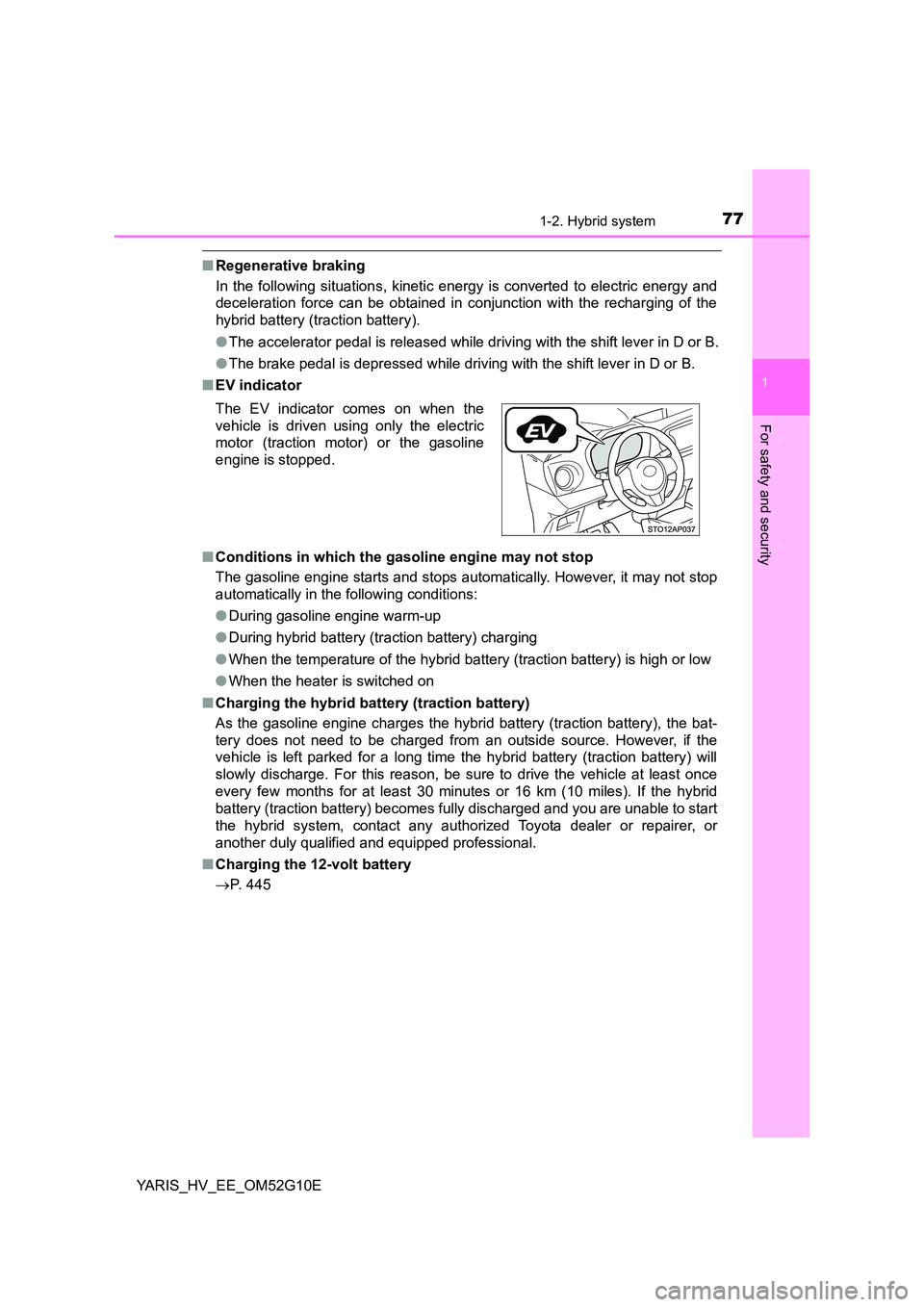
771-2. Hybrid system
1
For safety and security
YARIS_HV_EE_OM52G10E
■Regenerative braking
In the following situations, kinetic ener gy is converted to electric energy and
deceleration force can be obtained in conjunction with the recharging of the
hybrid battery (traction battery).
● The accelerator pedal is released while driving with the shift lever in D or B.
● The brake pedal is depressed while driving with the shift lever in D or B.
■ EV indicator
■ Conditions in which the gasoline engine may not stop
The gasoline engine starts and stops automatically. However, it may not stop
automatically in the following conditions:
● During gasoline engine warm-up
● During hybrid battery (traction battery) charging
● When the temperature of the hybrid battery (traction battery) is high or low
● When the heater is switched on
■ Charging the hybrid battery (traction battery)
As the gasoline engine charges the hybrid battery (traction battery), the bat-
tery does not need to be charged from an outside source. However, if the
vehicle is left parked for a long time t he hybrid battery (traction battery) will
slowly discharge. For this reason, be sure to drive the vehicle at least once
every few months for at least 30 minutes or 16 km (10 miles). If the hybrid
battery (traction battery) becomes fully discharged and you are unable to start
the hybrid system, contact any authorized Toyota dealer or repairer, or
another duly qualified and equipped professional.
■ Charging the 12-volt battery
P. 445
The EV indicator comes on when the
vehicle is driven using only the electric
motor (traction motor) or the gasoline
engine is stopped.
Page 93 of 492
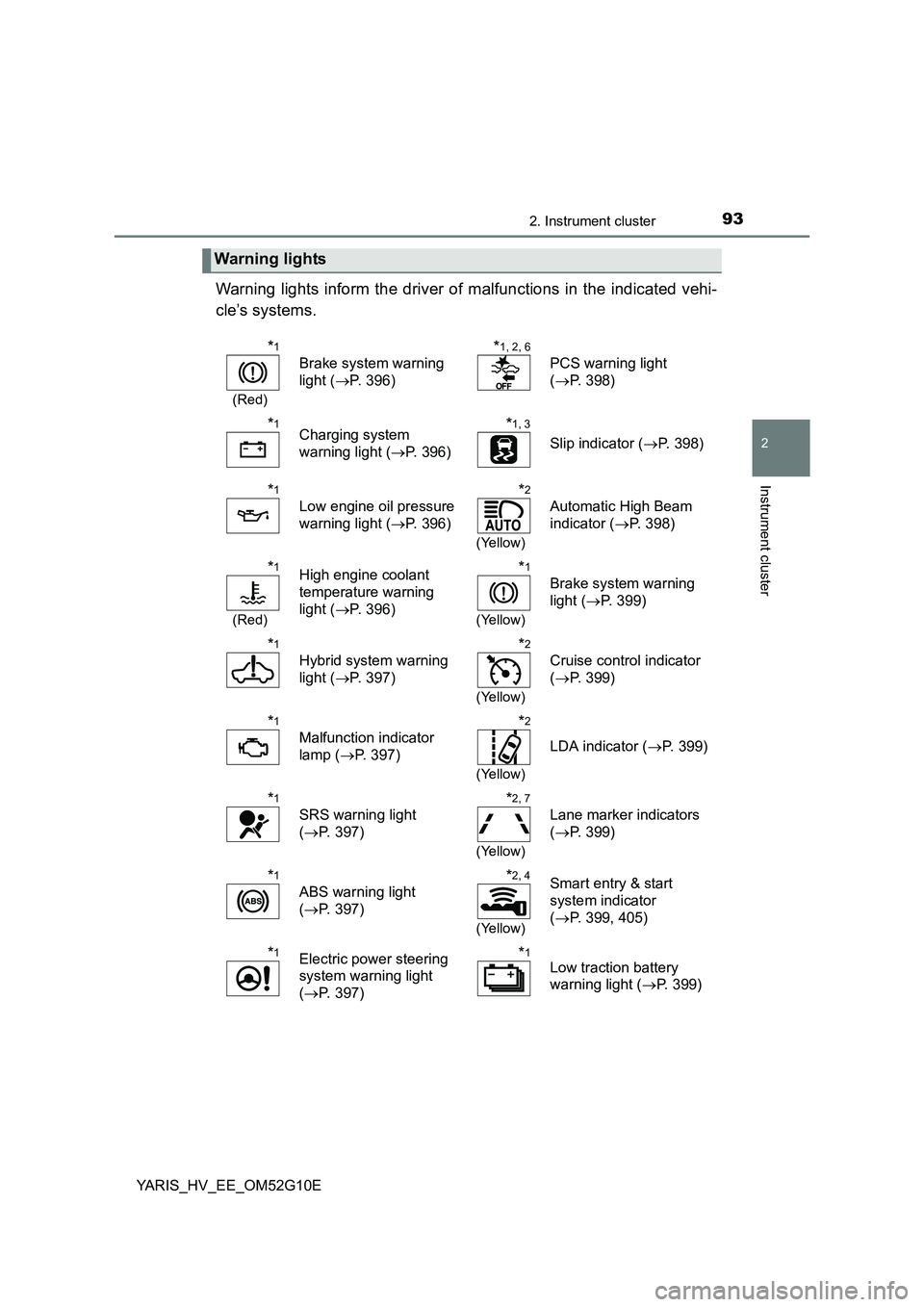
932. Instrument cluster
2
Instrument cluster
YARIS_HV_EE_OM52G10E
Warning lights inform the driver of malfunctions in the indicated vehi-
cle’s systems.
Warning lights
*1
(Red)
Brake system warning
light ( P. 396)
*1, 2, 6
PCS warning light
( P. 398)
*1Charging system
warning light ( P. 396)
*1, 3
Slip indicator (P. 398)
*1
Low engine oil pressure
warning light ( P. 396)
*2
(Yellow)
Automatic High Beam
indicator ( P. 398)
*1
(Red)
High engine coolant
temperature warning
light ( P. 396)
*1
(Yellow)
Brake system warning
light ( P. 399)
*1
Hybrid system warning
light ( P. 397)
*2
(Yellow)
Cruise control indicator
( P. 399)
*1
Malfunction indicator
lamp ( P. 397)
*2
(Yellow)
LDA indicator (P. 399)
*1
SRS warning light
( P. 397)
*2, 7
(Yellow)
Lane marker indicators
( P. 399)
*1
ABS warning light
( P. 397)
*2, 4
(Yellow)
Smart entry & start
system indicator
( P. 399, 405)
*1Electric power steering
system warning light
( P. 397)
*1
Low traction battery
warning light ( P. 399)
Page 99 of 492
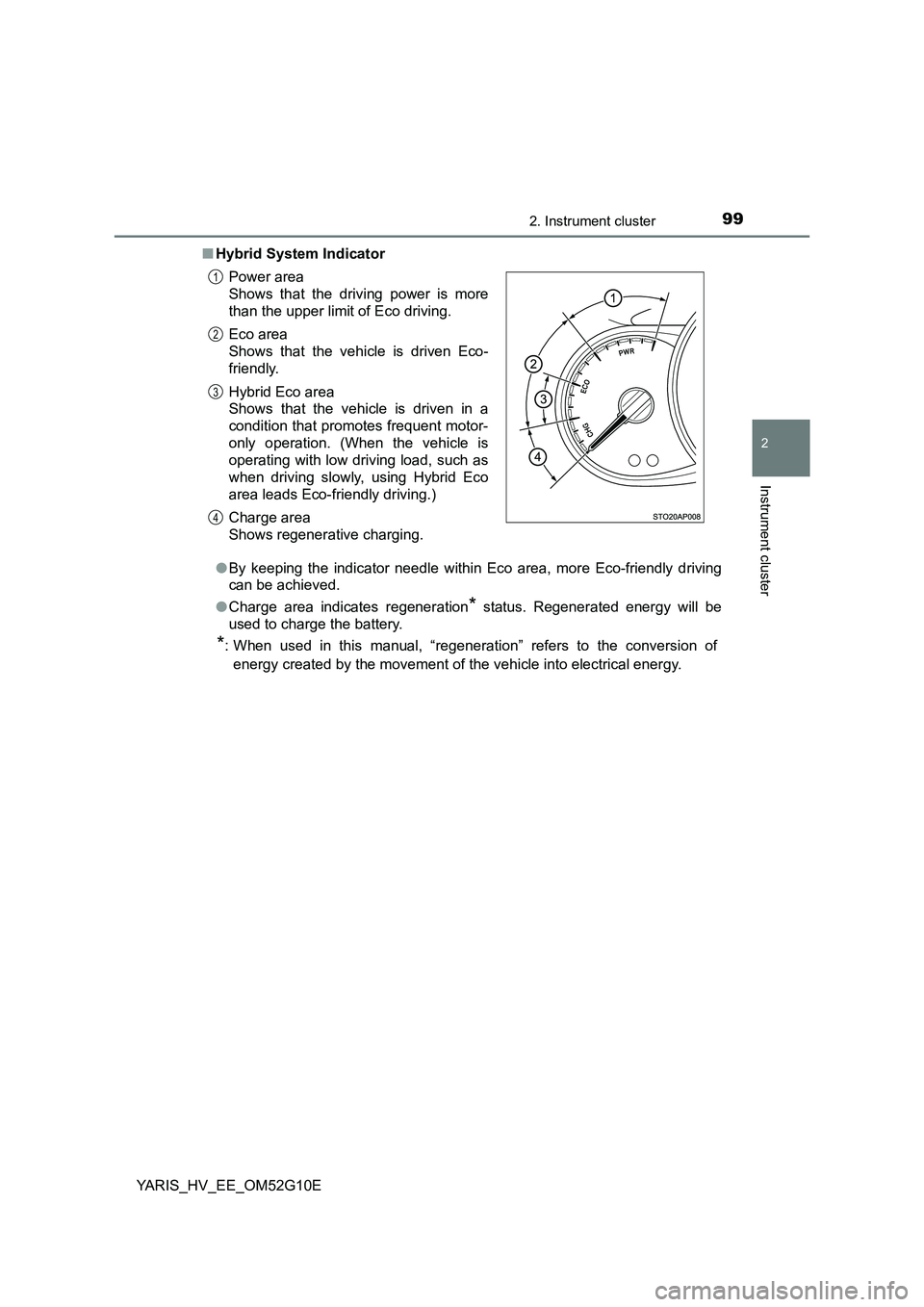
992. Instrument cluster
2
Instrument cluster
YARIS_HV_EE_OM52G10E
■ Hybrid System Indicator
● By keeping the indicator needle within Eco area, more Eco-friendly driving
can be achieved.
● Charge area indicates regeneration* status. Regenerated energy will be
used to charge the battery.
*: When used in this manual, “regeneration” refers to the conversion of
energy created by the movement of the vehicle into electrical energy.
Power area
Shows that the driving power is more
than the upper limit of Eco driving.
Eco area
Shows that the vehicle is driven Eco-
friendly.
Hybrid Eco area
Shows that the vehicle is driven in a
condition that promotes frequent motor-
only operation. (When the vehicle is
operating with low driving load, such as
when driving slowly, using Hybrid Eco
area leads Eco-friendly driving.)
Charge area
Shows regenerative charging.
1
2
3
4
Page 105 of 492
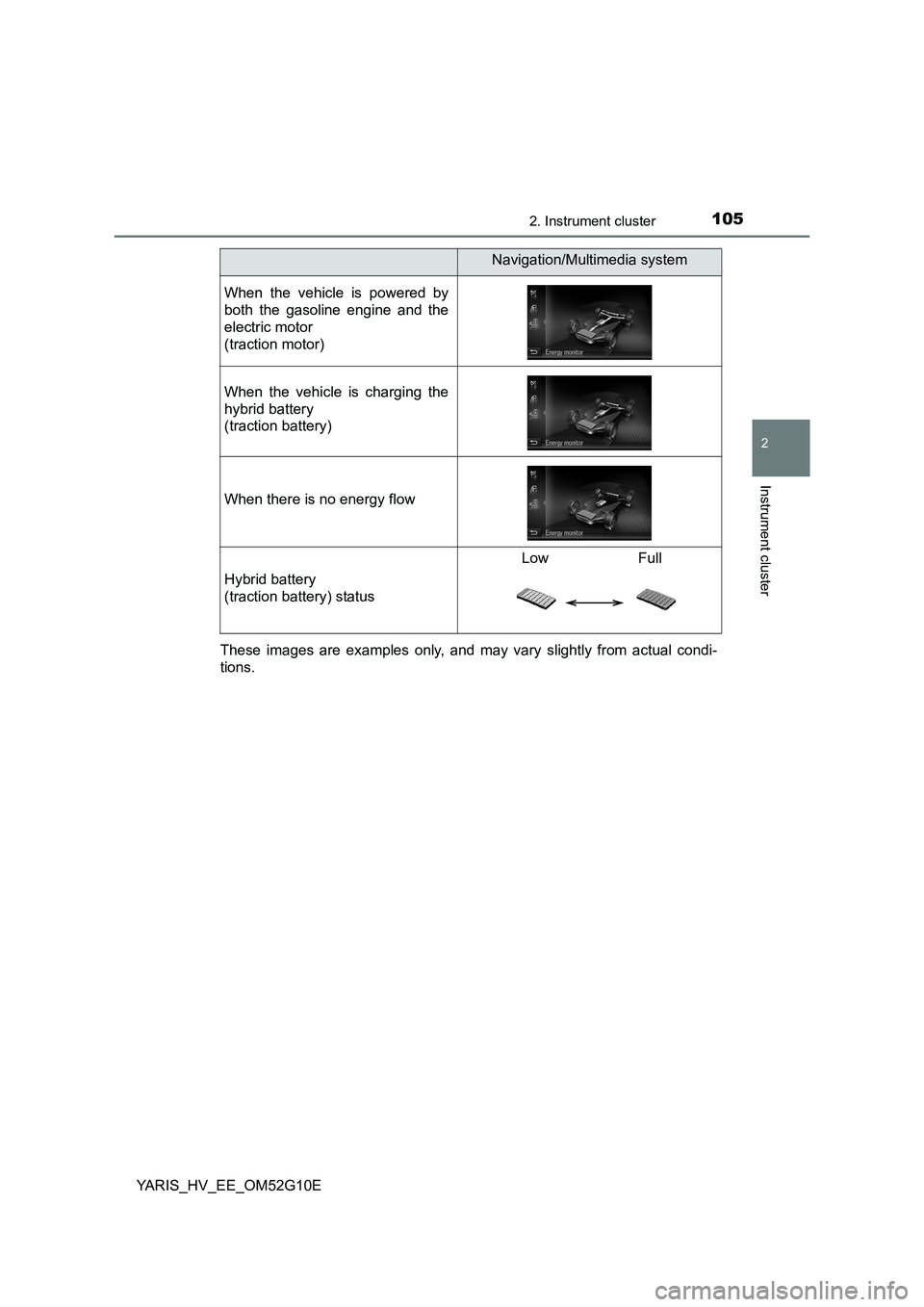
1052. Instrument cluster
2
Instrument cluster
YARIS_HV_EE_OM52G10E
These images are examples only, and may vary slightly from actual condi-
tions.
When the vehicle is powered by
both the gasoline engine and the
electric motor
(traction motor)
When the vehicle is charging the
hybrid battery
(traction battery)
When there is no energy flow
Hybrid battery
(traction battery) status
Low Full
Navigation/Multimedia system
Page 113 of 492
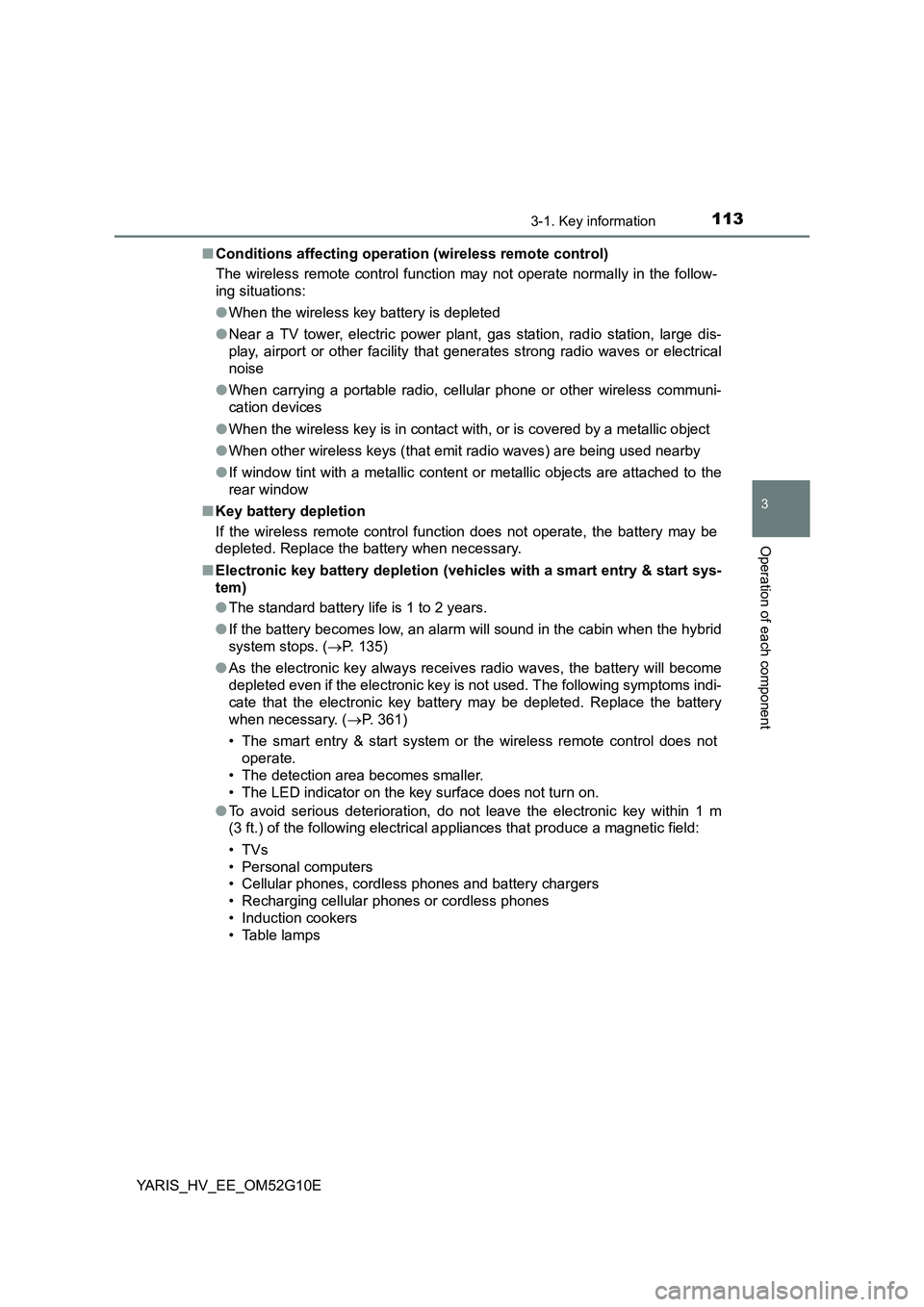
1133-1. Key information
3
Operation of each component
YARIS_HV_EE_OM52G10E
■ Conditions affecting operation (wireless remote control)
The wireless remote control function may not operate normally in the follow-
ing situations:
● When the wireless key battery is depleted
● Near a TV tower, electric power plant, gas station, radio station, large dis-
play, airport or other facility that generates strong radio waves or electrical
noise
● When carrying a portable radio, cellular phone or other wireless communi-
cation devices
● When the wireless key is in contact with, or is covered by a metallic object
● When other wireless keys (that emit radio waves) are being used nearby
● If window tint with a metallic content or metallic objects are attached to the
rear window
■ Key battery depletion
If the wireless remote control function does not operate, the battery may be
depleted. Replace the battery when necessary.
■ Electronic key battery depletion (vehicles with a smart entry & start sys-
tem)
● The standard battery life is 1 to 2 years.
● If the battery becomes low, an alarm will sound in the cabin when the hybrid
system stops. ( P. 135)
● As the electronic key always receives radio waves, the battery will become
depleted even if the electronic key is not used. The following symptoms indi-
cate that the electronic key battery may be depleted. Replace the battery
when necessary. ( P. 361)
• The smart entry & start system or the wireless remote control does not
operate.
• The detection area becomes smaller.
• The LED indicator on the key surface does not turn on.
● To avoid serious deterioration, do not leave the electronic key within 1 m
(3 ft.) of the following electrical appliances that produce a magnetic field:
•TVs
• Personal computers
• Cellular phones, cordless phones and battery chargers
• Recharging cellular phones or cordless phones
• Induction cookers
• Table lamps
Page 192 of 492
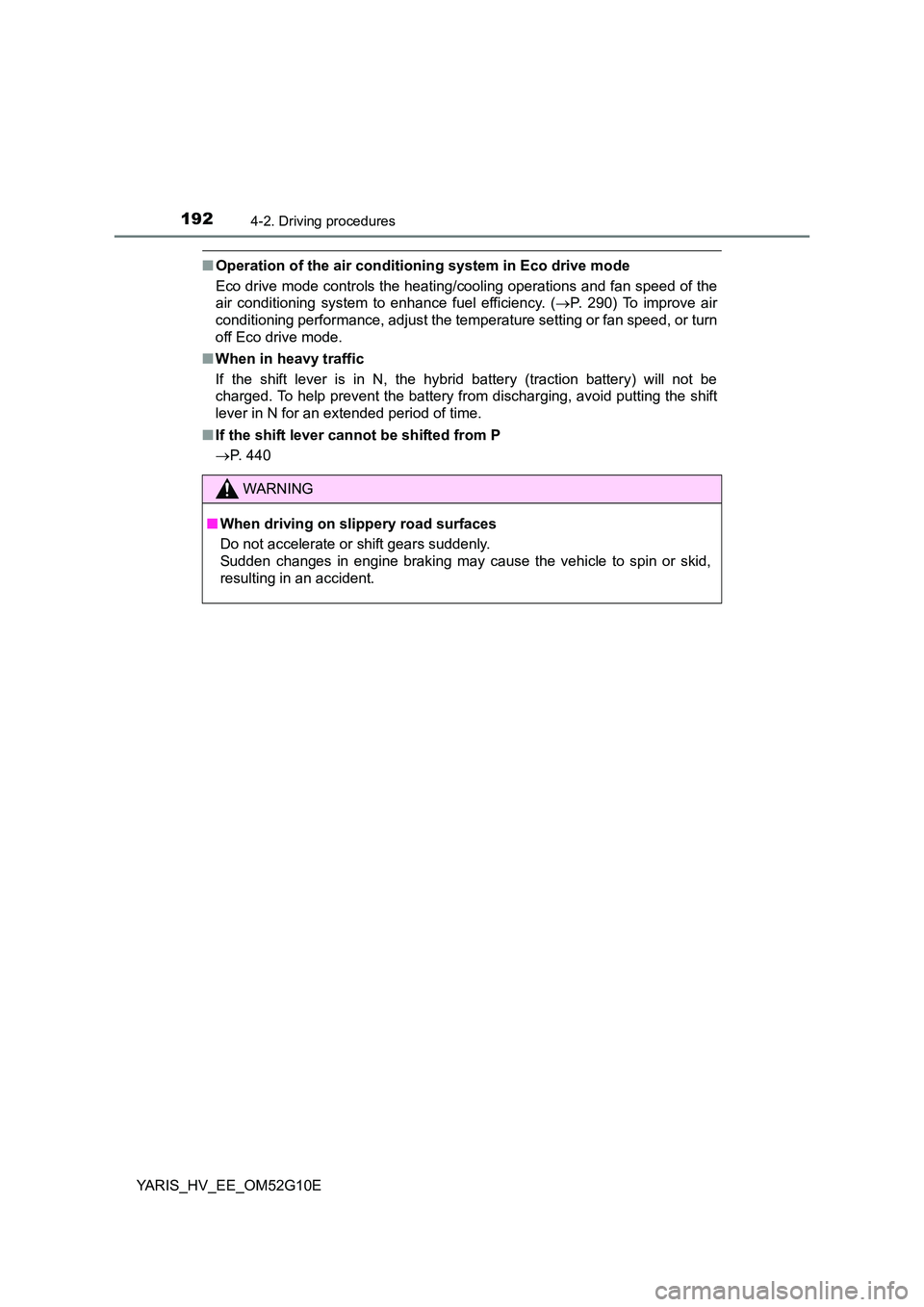
1924-2. Driving procedures
YARIS_HV_EE_OM52G10E
■Operation of the air conditioning system in Eco drive mode
Eco drive mode controls the heating/cooling operations and fan speed of the
air conditioning system to enhance fuel efficiency. ( P. 290) To improve air
conditioning performance, adjust the temper ature setting or fan speed, or turn
off Eco drive mode.
■ When in heavy traffic
If the shift lever is in N, the hybrid battery (traction battery) will not be
charged. To help prevent the battery fr om discharging, avoid putting the shift
lever in N for an extended period of time.
■ If the shift lever cannot be shifted from P
P. 440
WARNING
■When driving on slippery road surfaces
Do not accelerate or shift gears suddenly.
Sudden changes in engine braking may cause the vehicle to spin or skid,
resulting in an accident.
Page 337 of 492
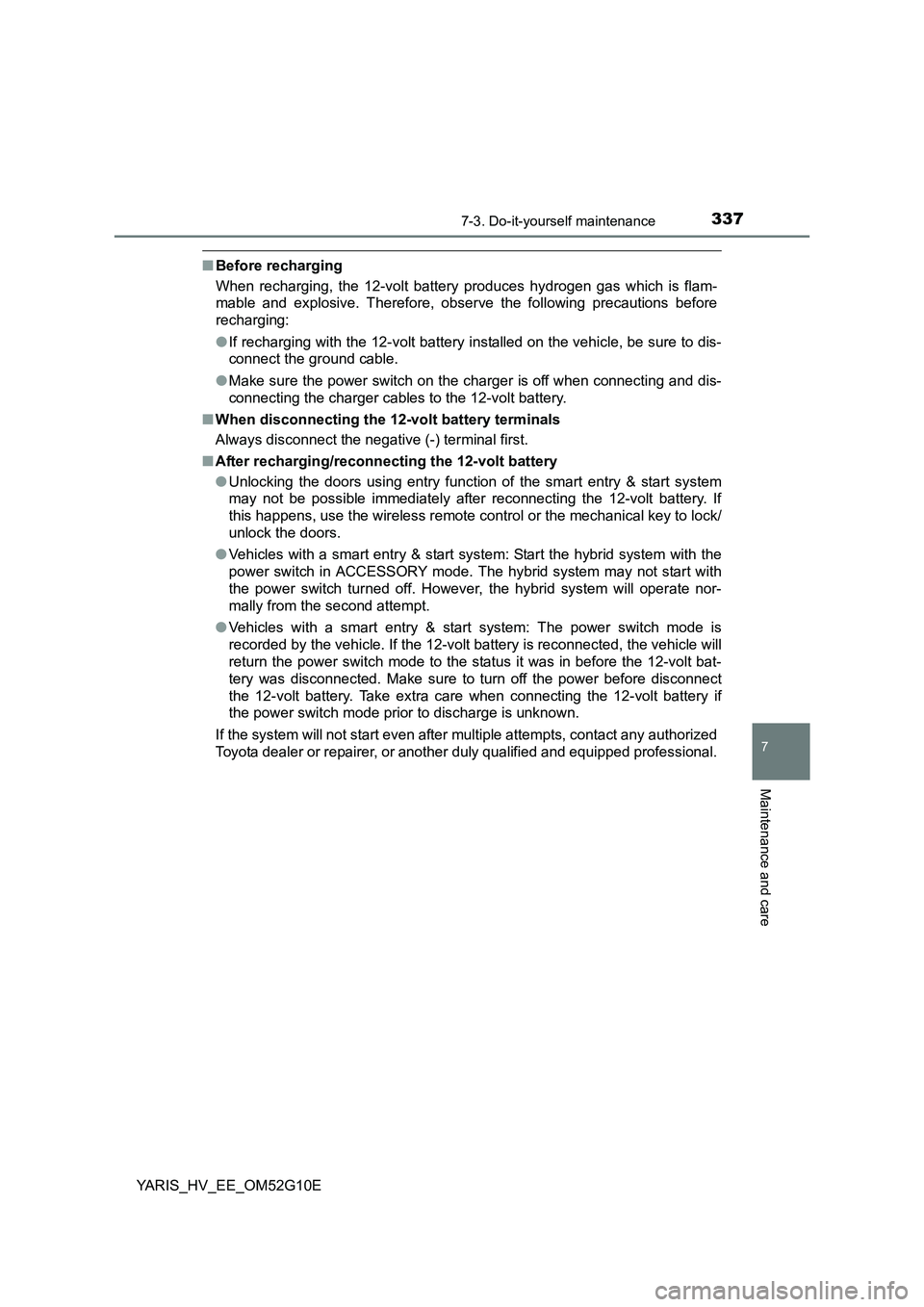
3377-3. Do-it-yourself maintenance
7
Maintenance and care
YARIS_HV_EE_OM52G10E
■Before recharging
When recharging, the 12-volt battery produces hydrogen gas which is flam-
mable and explosive. Therefore, obser ve the following precautions before
recharging:
● If recharging with the 12-volt battery installed on the vehicle, be sure to dis-
connect the ground cable.
● Make sure the power switch on the charger is off when connecting and dis-
connecting the charger cables to the 12-volt battery.
■ When disconnecting the 12-volt battery terminals
Always disconnect the negative (-) terminal first.
■ After recharging/reconnecting the 12-volt battery
● Unlocking the doors using entry function of the smart entry & start system
may not be possible immediately after reconnecting the 12-volt battery. If
this happens, use the wireless remote control or the mechanical key to lock/
unlock the doors.
● Vehicles with a smart entry & start system: Start the hybrid system with the
power switch in ACCESSORY mode. The hybrid system may not start with
the power switch turned off. However, the hybrid system will operate nor-
mally from the second attempt.
● Vehicles with a smart entry & start system: The power switch mode is
recorded by the vehicle. If the 12-volt battery is reconnected, the vehicle will
return the power switch mode to the status it was in before the 12-volt bat-
tery was disconnected. Make sure to turn off the power before disconnect
the 12-volt battery. Take extra care when connecting the 12-volt battery if
the power switch mode prior to discharge is unknown.
If the system will not start even after multiple attempts, contact any authorized
Toyota dealer or repairer, or another duly qualified and equipped professional.
Page 339 of 492
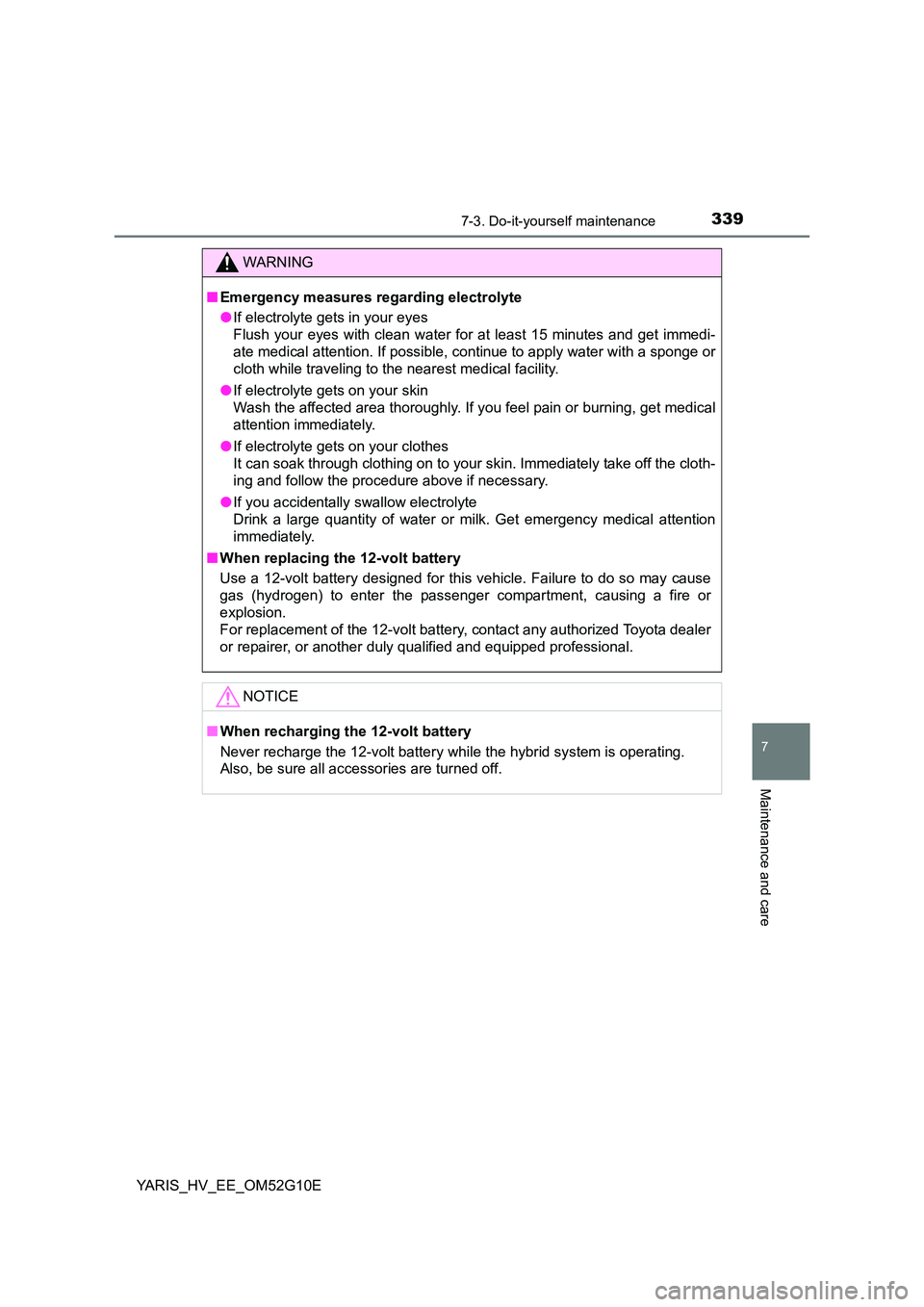
3397-3. Do-it-yourself maintenance
7
Maintenance and care
YARIS_HV_EE_OM52G10E
WARNING
■Emergency measures regarding electrolyte
● If electrolyte gets in your eyes
Flush your eyes with clean water for at least 15 minutes and get immedi-
ate medical attention. If possible, continue to apply water with a sponge or
cloth while traveling to the nearest medical facility.
● If electrolyte gets on your skin
Wash the affected area thoroughly. If you feel pain or burning, get medical
attention immediately.
● If electrolyte gets on your clothes
It can soak through clothing on to your skin. Immediately take off the cloth-
ing and follow the procedure above if necessary.
● If you accidentally swallow electrolyte
Drink a large quantity of water or milk. Get emergency medical attention
immediately.
■ When replacing the 12-volt battery
Use a 12-volt battery designed for this vehicle. Failure to do so may cause
gas (hydrogen) to enter the passenger compartment, causing a fire or
explosion.
For replacement of the 12-volt battery, contact any authorized Toyota dealer
or repairer, or another duly qualified and equipped professional.
NOTICE
■ When recharging the 12-volt battery
Never recharge the 12-volt battery while the hybrid system is operating.
Also, be sure all accessories are turned off.
Page 396 of 492
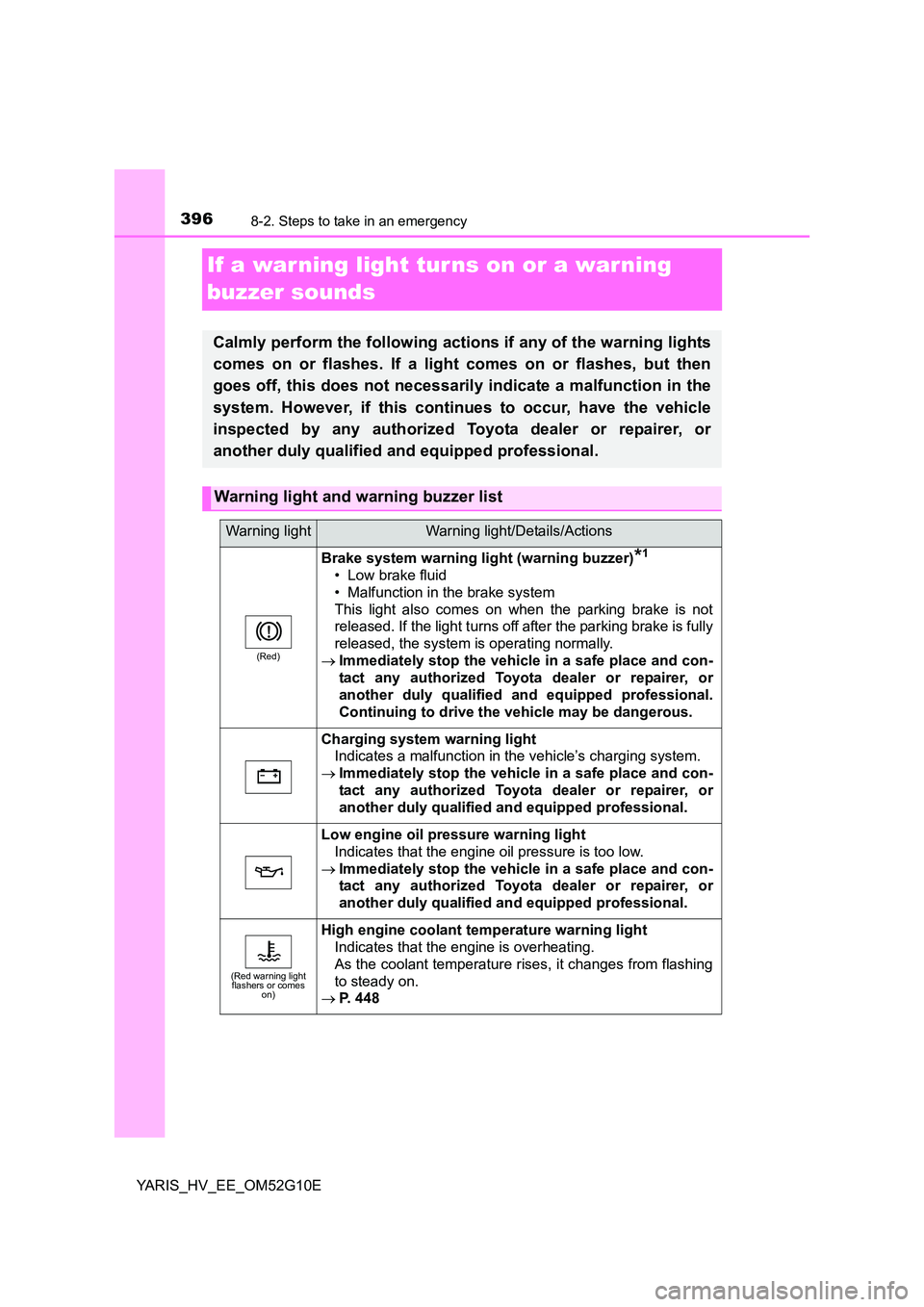
3968-2. Steps to take in an emergency
YARIS_HV_EE_OM52G10E
If a war ning light tur ns on or a warning
buzzer sounds
Calmly perform the following actions if any of the warning lights
comes on or flashes. If a light comes on or flashes, but then
goes off, this does not necessarily indicate a malfunction in the
system. However, if this continues to occur, have the vehicle
inspected by any authorized Toyota dealer or repairer, or
another duly qualified and equipped professional.
Warning light and warning buzzer list
Warning lightWarning light/Details/Actions
(Red)
Brake system warning light (warning buzzer)*1
• Low brake fluid
• Malfunction in the brake system
This light also comes on when the parking brake is not
released. If the light turns off after the parking brake is fully
released, the system is operating normally.
Immediately stop the vehicle in a safe place and con-
tact any authorized Toyota dealer or repairer, or
another duly qualified and equipped professional.
Continuing to drive the vehicle may be dangerous.
Charging system warning light
Indicates a malfunction in the vehicle’s charging system.
Immediately stop the vehicle in a safe place and con-
tact any authorized Toyota dealer or repairer, or
another duly qualified and equipped professional.
Low engine oil pressure warning light
Indicates that the engine oil pressure is too low.
Immediately stop the vehicle in a safe place and con-
tact any authorized Toyota dealer or repairer, or
another duly qualified and equipped professional.
(Red warning light flashers or comes on)
High engine coolant temperature warning light
Indicates that the engine is overheating.
As the coolant temperature rises, it changes from flashing
to steady on.
P. 448